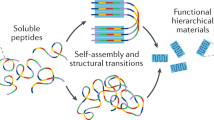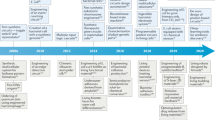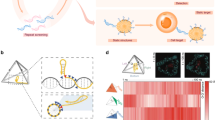Abstract
Proteins, through their unique and specific interactions with other macromolecules and inorganics, control structures and functions of all biological hard and soft tissues in organisms. Molecular biomimetics is an emerging field in which hybrid technologies are developed by using the tools of molecular biology and nanotechnology. Taking lessons from biology, polypeptides can now be genetically engineered to specifically bind to selected inorganic compounds for applications in nano- and biotechnology. This review discusses combinatorial biological protocols, that is, bacterial cell surface and phage-display technologies, in the selection of short sequences that have affinity to (noble) metals, semiconducting oxides and other technological compounds. These genetically engineered proteins for inorganics (GEPIs) can be used in the assembly of functional nanostructures. Based on the three fundamental principles of molecular recognition, self-assembly and DNA manipulation, we highlight successful uses of GEPI in nanotechnology.
This is a preview of subscription content, access via your institution
Access options
Subscribe to this journal
Receive 12 print issues and online access
$259.00 per year
only $21.58 per issue
Buy this article
- Purchase on Springer Link
- Instant access to full article PDF
Prices may be subject to local taxes which are calculated during checkout






Similar content being viewed by others
References
Thompson, D.W. On the Growth and Form (Cambridge Univ. Press, Cambridge, UK, 1942).
Stevens, P.S. Patterns in Nature (Atlantic Monthly, Boston, 1974).
Wainwright, S.A., Biggs, W.D., Currey, J.D. & Gosline, J.M. (eds) Mechanical Design in Organisms (Princeton Univ. Press, Princeton, 1976).
Vogel, S. Cats' Paws and Catapults (W.W. Norton & Company, New York, 1998).
Mann, S. & Calvert, P. Synthesis and biological composites formed by in-situ precipitation. J. Mater. Sci. 23, 3801–3815 (1988).
Sarikaya, M. & Aksay, I.A. (eds.) Biomimetics: Design & Processing of Materials (American Institute of Physics, New York, 1995).
Mann, S. (ed.) Biomimetic Materials Chemistry (VCH, New York, 1996).
Niemeyer, C.M. Nanoparticles, proteins, and nucleic acids: Biotechnology meets materials science. Angew. Chem. Int. Edn Engl. 40, 4128–4158 (2001).
Drexler, K.E. Nanosystems (Wiley Interscience, New York, 1992).
Ryu, D.D.Y. & Nam, D.H. Recent progress in biomolecular engineering. Biotechnol. Prog. 16, 2–16 (2000).
Sarikaya, M. Biomimetics: Materials fabrication through biology. Proc. Natl Acad. Sci. USA 96, 14183–14185 (1999).
Seeman, N.C. & Belcher, A.M. Emulating biology: building nanostructures from the bottom up. Proc. Natl Acad. Sci. USA 99, 6452–6455 (2002).
Ball, P. Life's lessons in design. Nature 409, 413–416 (2001).
Ferry, D.K. & Goodnick, S.M. Transport in Nanostructures (Cambridge Univ. Press, Cambridge, UK, 1997).
Harris, P.J. Carbon Nanotubes and Related Structures (Cambridge Univ. Press, Cambridge, UK, 1999).
Bachtold, A., Hadley, P., Nakanishi, T. & Dekker, C. Logic circuits with carbon nanotubes transistors. Science 294, 1317–1320 (2001).
Gittins, D.I., Bethell, D., Schiffrin, D.J. & Michols, R.J. A nanometre-scale electronic switch consisting of a metal cluster and redox-addressable groups. Nature 408, 67–69 (2000).
Muller, B. Natural formation of nanostructures: from fundamentals in metal heteroepitaxy to applications in optics and biomaterials science. Surf. Rev. Lett. 8, 169–228 (2001).
Kaplan, D., Adams, W.W., Farmer, B. & Viney, C. Silk-biology, structure, properties, and genetics. Silk Polymers ACS Symposium Series 544, 2–16 (1994).
Lowenstam, H.A. & Weiner, S. On Biomineralization (Oxford Univ. Press, Oxford, UK, 1989).
Mayer, G. & Sarikaya, M. Rigid biological composite materials: Structural examples for biomimetic design. Exp. Mech. 42, 395–403 (2002).
Fong, H., Sarikaya, M., White, S. & Snead, M.L. Nanomechanical properties profiles across DEJ in human incisor teeth. J. Mater. Sci. Eng C 7, 119–128 (2000).
Sarikaya, M. et al. Biomimetic model of a sponge-spicular optical fiber - mechanical properties and structure. J. Mater. Res. 16, 1420–1428 (2001).
DeGarmo, E.P., Black, J.T. & Kohner, R.A. Materials and Processes in Manufacturing (McMillan, New York, 1988).
Sarikaya, M., Steinberg, B. & Thomas, G. Optimization of Fe/Cr/C base structural steels for improved strength and toughness. Metall. Trans. A 13, 2227–2237 (1982).
Ponting, C.P. & Russell, R.R. The natural history of protein domains. Ann. Rev. Biophys. Biomol. 31, 45–71 (2002).
Izrailev, S., Stepaniants, S., Balsera, M., Oono, Y. & Schulten, K. Molecular dynamics study of unbinding of avidin-biotin complex. Biophys. J. 72, 1568–1581 (1997).
Schonbrun, J., Wedemeyer, W.J. & Baker, D. Protein structure prediction in 2002. Curr. Opin. Struct. Biol. 12, 348–354 (2002).
Brown, S. Metal recognition by repeating polypeptides. Nature Biotechnol. 15, 269–272 (1997).
Schneider, G. & Wrede, P. Artificial neural networks for computer-based molecular design. Biophys. Mol. Biol. 70, 175–222 (1998).
Cariolou, M.A. & Morse, D.E. Purification and characterization of calcium-binding conchiolin shell peptides from the mollusk, Haliotis-rufescens, as a function of development. J. Comp. Physiol. B 157, 717–729 (1988).
Glimcher, M. & Nimni, M. Collagen cross-linking and biomineralization. Connect Tissue Res. 27, 73–83 (1992).
Paine, M.L. & Snead, M.L. Protein interactions during assembly of the enamel organic extracellular matrix. J. Bone Mineral. Res. 12, 221–226 (1996).
Kroger, N., Deutzman, R. & Sumper, M. Polycatyonic peptides from diatom biosilica that direct silica nanosphere formation. Science 286, 1129–1132 (1999).
Liou, Y.C., Tocilj, A., Davies, P.L. & Jia, Z.C. Mimicry of ice structure by surface hydroxyls and water of a beta-helix antifreeze protein. Nature 406, 322–324 (2000).
Berman, A., Addadi, L. & Weiner, S. Interactions of sea-urchin skeleton macromolecules with growing calcite crystals: A study of intracrystalline proteins. Nature 331, 546–548 (1988).
Weizbicki, A., Sikes, C.S., Madura, J.D. & Drake, B. Atomic force microscopy and molecular modeling of proteins and peptide binding to calcite. Calcif. Tissue. Int. 54, 133–141 (1994).
Cha, J.N. et al. Silicatein filaments and subunits from a marine sponge direct the polymerization of silica and silicones in vitro. Proc. Natl Acad. Sci. USA 96, 361–365 (1999).
Belcher, A.M. et al. Control of crystal phase switching and orientation by soluble mollusk-shell proteins. Nature 381, 56–58 (1996).
Falini, G., Albeck, S., Weiner, S. & Addadi, L. Control of aragonite and calcite polmorphism by mollusk shell macromolecules. Science 271, 67–69 (1996).
Giver, L. & Arnold, F.H. Combinatorial protein design by in vitro recombination. Curr. Opin. Chem. Biol. 2, 335–338 (1998).
Schembri, M.A., Kjergaard, K. & Klemm, P. Bioaccumulation of heavy metals by fimbrial designer adhesion. FEMS Microbiol. Lett. 170, 363–371 (1999).
Brown, S., Sarikaya, M. & Johnson, E. Genetic analysis of crystal growth. J. Mol. Biol. 299, 725–732 (2000).
Whaley, S.R., English, D.S., Hu, E.L., Barbara, P.F. & Belcher, M.A. Selection of peptides with semiconducting binding specificity for directed nanocrystal assembly. Nature 405, 665–668 (2000).
Naik, R.R., Brott, L., Carlson, S.J. & Stone, M.O. Silica precipitating peptides isolated from a combinatorial phage display libraries. J. Nanosci. Nanotechnol. 2, 1–6 (2002).
Smith, G.P. Filamentous fusion phage: Novel expression vectors that display cloned antigens on the virion surface. Science 228, 1315–1317 (1985).
Hoess, R.H. Protein design and phage display. Chem. Rev. 101, 3205–3218 (2001).
Wittrup, K.D. Protein engineering by cell surface display. Curr. Opin. Biotechnol. 12, 395–399 (2001).
Rosander, A., Bjerketorp, J., Frykberg, L. & Jacobsson, K. Phage display as a novel screening method to identify extracellular proteins. J. Microbiol. Meth. 51, 43–55 (2002).
Petrouna, I.P. & Arnold, F.H. Designed evolution of enzymatic properties. Curr. Opin. Biotechnol. 11, 325–329 (2000).
Smith, G.P. & Petrenko, A. Phage display. Chem. Rev. 97, 391–410 (1997).
Benhar, I. Biotechnology applications of phage and cell surface display. Biotechnol. Adv. 19, 1–33 (2001).
Amstatz, P., Forrer, P., Zahnd, C. & Plückthun, A. In vitro display technologies: novel developments and applications. Curr. Opinion Biotechnol. 12, 400–405 (2001).
Naik, R.R., Stringer, S.J., Agarwal, G., Jones, S.E. & Stone, M.O. Biomimetic synthesis and patterning of silver nanoparticles. Nature Mater. 1, 169–172 (2002).
Lee, W.S., Mao, C., Flynn, C.E. & Belcher, A.M. Ordering quantum dots using genetically engineered viruses. Science 296, 892–895 (2002).
Kiargaard, K., Sorensen, J.K., Schembri, M.A. & Klemm, P. Sequestration of zinc oxide by fimbrial designer chelators. Appl. Env. Microbiol. 66, 10–14 (2000).
Nygaard, S., Wandelbo, R. & Brown, S. Surface-specific zeolite-binding proteins. Adv. Mater. 14, 1853–1856 (2002).
Gaskin, D.J.H., Starck, K. & Vulfson, E.N. Identification of inorganic crystal-specific seqeunces using phage display combinatorial library of short peptides: A feasibility study. Biotech. Lett. 22, 1211–1216 (2000).
Scembri, M.A., Kjaergaard, K. & Klemm, P. Bioaccumulation of heavy metals by fimbrial designer adhesions. FEMS Microbial. Lett. 170, 363–371 (1999).
Brown, S. Engineering iron oxide-adhesion mutants of Escherichia coli phage λ receptor. Proc. Natl Acad. Sci. USA 89, 8651–8655 (1992).
Mann, S. Molecular recognition in biomineralization. Nature 332, 119–123 (1988).
Weissbuch, I., Addadi, L., Lahav, M. & Leiserowitz, L. Molecular recognition at crystal interfaces. Science 253, 637–645 (1991).
Sarikaya, M., Fong, H., Heidel, D. & Humbert, R. Biomimetic assembly of nanostructured materials. Mater. Sci. Forum 293, 83–87 (1999).
Slocik, J.M., Moore, J.T. & Wright, D.W. Monoclonal antibody recognition of histidine-rich peptide capsulated nanoclusters. Nano Lett. 2, 169–173 (2002).
Braun, R., Sarikaya, M. & Schulten, K.S. Genetically engineered gold-binding polypeptides: Structure prediction and molecular dynamics. J. Biomater. Sci. 13, 747–758 (2002).
Frankel, R.B. & Blakemore, R.P. (eds) Iron Biominerals (Plenum, New York, 1991).
Klaus,T., Joerger, R., Olsson, E. & Granqvist,C.-G. Silver-based crystalline nanoparticles bacterially fabricated. Proc. Natl Acad. Sci. USA 96, 13611–13614 (1999).
Mukharjee, P. et al. Extracellular synthesis of gold nanoparticles by the fungus Fusarium oxysporum. Chem. Biol. Chem. 5, 461–463 (2002).
Turkevich, J., Stevenson, P.C. & Hillier, J. A study of the nucleation and growth of processes in the synthesis of colloidal gold. Trans. Faraday Soc. 11, 55–75 (1951).
Kempa, K. et al. Photonic crystals based on periodic arrays of aligned carbon nanotubes. Nano Lett. 3, 13–18 (2003).
Beverly, K.C. Quantum dot artificial solids: Understanding the static and dynamic role of size and packing disorder. Proc. Natl Acad. Sci. USA 99, 6456–6459 (2002).
Djulali, R., Chen, Y. & Matsui, H. Au nanowires from sequenced histidine-rich peptide. J. Am. Chem. Soc. 124, 13660–13661 (2002).
Xia, Y. & Sun, Y. Shape-controlled synthesis of gold and silver nanoparticles. Science 298, 2176–2179 (2002).
Schreiber, R. Structure and growth of self-assembled monolayers. Prog. Surf. Sci. 65, 151–256 (2000).
Whitesides, G.M., Mathias, J.P. & Seto, C.T. Molecular Self-assembly and nanochemistry-A chemical strategy for the synthesis of nanostructures. Science 254, 1312–1319 (1991).
Brown, S. Protein-mediated particle assembly. Nano Lett. 1, 391–394 (2001).
Piner, R.D., Zhu, J., Xu, F., Seunghun, H. & Mirkin, C.A. 'Dip-pen' nanolithography. Science 283, 661–663 (1999).
Ratner, B., Schoen, F., Hoffman, A. & Lemons, J. (eds) Biomaterials Science: Introduction to Materials in Medicine (Academic, San Diego, USA, 1996).
Mrksich, M. What can surface chemistry do for cell biology. Curr. Opin. Chem. Biol. 6, 794–797 (2002).
Chen, X.X., Ferrigno, R., Yang, J. & Whitesides, G.A. Redox properties of cytochrome c adsorbed on self-assembled monolayers: A probe for protein conformation and orientation. Langmuir 18, 7009–7015 (2002).
Jung, L.S., Campbell, C.T., Chinowsky, T.M., Mar, M.N. & Yee, S.S. Quantitative interpretation of the resonance of surface plasmon resonance sensors to adsorbed films. Langmuir 14, 5636–5648 (1998).
Long, J.R., Shaw, W.J., Stayton, P.S. & Drobny, G.P. Structure and dynamics of hydrated statherin on hydroxyapatite as determined by solid-state NMR. Biochemistry-US 40, 15451–15455 (2001).
Epstein, J.R., Biran, I. & Walt, D.R. Fluorescence based nucleic acid detection and microarrays. Anal. Chim Acta. 469, 3–36 (2002).
Chicurel, M.E., & Dalma-Weiszhausz, D.D. Microarrays in pharmagenomics – advances and future promise. Pharmacogenomics 3, 589–601 (2002).
Yarmush, M.L. & Yarayam, A. Advances in proteomics technologies. Annu. Rev. Biomed. Eng. 4, 349–373 (2002).
Koneracka, M. et al. Direct binding procedures of proteins to fine magnetic particles. J. Mol. Catal. B 18, 13–18 (2002).
Asefa, T., Ozin, G.A., Grondey, H., Kruk, H. & Jaroniek, M. Recent developments in the synthesis and chemistry of periodic mesoporous organosilicas. Stud. Surf. Sci Catal. 141, 1–26 (2002).
Evans, E., Bowman, H., Leung, A., Needham, D. & Tirrell, D. Biomembrane templates for nanoscale conduits and networks. Science 273, 933–935 (1996).
Hartgerink, J.D., Beniash, E. & Stupp, S.I. Self-assembly and mineralization of peptide-amphiphile nanofibers. Science 294, 1684–1688 (2001).
Keren, K. et al. Sequence specific molecular lithography on single DNA molecules. Science 97, 72–75 (2002).
Moll, D. et al. S-layer-streptavidin fusion proteins as template for nanopatterned molecular arrays. Proc. Natl Acad. Sci. USA 99, 14646–14651 (2002).
McMillan, A.R. et al. Ordered nanoparticle arrays formed on engineered chaperonin protein templates. Nature Mater. 1, 247–252 (2002).
Kelly, T.R. & Sestelo, J.P. Rotary motion in single-molecule machines. Struct. Bond. 99, 19–53 (2001).
Ishli, D. et al. Chaperorin-mediated stabilization and ATP-triggered release of semiconductor nanoparticles. Nature 423, 628–231 (2003).
Jackson, J.B., Westcott, S.L., Hirsch, L.R., West, J.L. & Halas, N.J. Controlling the surface enhanced RAMAN effect via the nanoshell geometry. Appl. Phys. Lett. 82, 257–259 (2002).
Haes, A.J. & Van Duyne, R.P. A nanoscale optical biosensor: Sensitivity and selectivity of an approach based on the localized surface plasmon resonance spectroscopy of triangular silver nanoparticles. J. Am. Chem. Soc. 124, 10596–10604 (2002).
Cutler, P. Protein Arrays: The current state-of-the-art. Proteomics 3, 3–18 (2003).
Acknowledgements
We thank our colleagues S. Brown (University of Copenhagen, Denmark), D. Schwartz, F. Ohuchi and B. Traxler for invaluable discussions, and S. Dincer, D. Heidel, R. Braun (Beckman Institute, University of Illinois), M. H. Zareie, V. Bulmus and H. Fong (all at University of Washington) for technical help. This research was supported by the US Army Research Office (Program Manager: Robert Campbell) through a DURINT Program (Defense University Research Initiative on Nanotechnology).
Author information
Authors and Affiliations
Corresponding author
Rights and permissions
About this article
Cite this article
Sarikaya, M., Tamerler, C., Jen, AY. et al. Molecular biomimetics: nanotechnology through biology. Nature Mater 2, 577–585 (2003). https://doi.org/10.1038/nmat964
Issue Date:
DOI: https://doi.org/10.1038/nmat964
This article is cited by
-
Lightweight Si3N4@SiO2 ceramic foam for thermal insulation and electromagnetic wave transparency
Nano Research (2023)
-
Multispecies design: 3D-printed biomimetic structures to enhance humidity levels
Architectural Intelligence (2023)
-
Advanced Functional Polymers: Properties and Supramolecular Phenomena in Hydrogels and Polyrotaxane-based Materials
Chemistry Africa (2023)
-
Effect of hydrophobic groups on adsorption of arginine-based amino acids to solid surfaces in water
Structural Chemistry (2023)
-
Self-assembled inorganic chiral superstructures
Nature Reviews Chemistry (2022)



